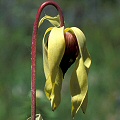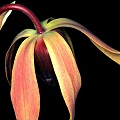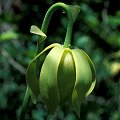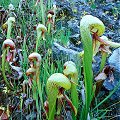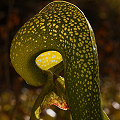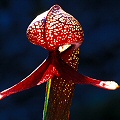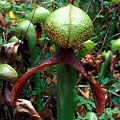Q: Darlingtonia: various types
A: Despite the wide variation in leaf coloration for this plant, and despite the fact that it occurs
in profoundly separated range segments, there does not appear to much real speciation in this genus. The only valid names for the plant are as
follows:
Darlingtonia californica Torr. f. californica
Darlingtonia californica f. viridiflora B.Rice
That second entity on the list is a name for a form of the plant that occurs, as a small subpopulation, at one site in the Sierra Nevada of
California. Yes, you might notice that the scientist naming that second plant has a name very similar to yours truly. Hey yeah, that's me!
This variant is characterized by the fact that it has no red pigmentation in the leaves or flowers.
I cannot tell you much about the site where f. viridiflora occurs, because it is a protected site on private property.
But I have a little trip report you can read, if you wish. See my botanical description in
McPherson & Schnell (2011) for more details.
This plant also goes by the cultivar name Darlingtonia 'Othello', also coined by yours truly on an
earlier date. Every now and then I have distributed seed of this plant to seed banks, but I do not have any now, so don't
ask---Thank you, thankyouverymuch.
Having spent a hefty amount of time looking at Darlingtonia, I have noticed a number of attractive pitcher and
flower variants. In addition to the color variants I describe below, I have seen plants with swept-back fangs, serrate fangs, or
extra-long sepals. There are
some very cool plants out there.
Green fangs
This is an overall green plant, with no major amount of red pigmentation. It is in effect the standard plant against which
others are compared. Some red pigmentation is present, so it is not an anthocyanin-free mutant.
Red-edge fangs
This looks very much like the green fangs plant, but with some pigmentation in the fangs. The pigmentation patterning is very
consistent. First, there is usually some pigment at the base of each fang. Second, the red in the
fangs is mostly constrained to the tissue between the outer edge of each fang, and the major vein that runs along the outer edge of
the fang. Not a very showy type in my estimation.
Blush fangs
This plant has a blush of red in the fangs, but even in bright light the pigmentation is not very dark. Often it is most
intense near the point of contact of the fang to the pitcher head.
Crimson fangs
Probably my favorite type, the fangs are uniformly pigmented a beautiful, deep red. The rest of the plant is largely green.
Red keel
This plant usually has nicely pigmented fangs. But what is really key is that the underside of the pitcher is red. The red can
extend to about halfway up the pitcher head. This plant is perhaps an intermediate between "crimson fangs" and
"crimson pitcher."
Crimson pitcher
The entire pitcher is intensely colored deep red. Don't confuse old, second year pitchers of other types for this plant. This kind of
plant has pitchers that are red the first year. Sometimes even the sepals are tinged red!
Page citations: Rice, B.A. 1997, 1998, 2001c, 2006a;
McPherson & Schnell 2011; Rondeau, J.H. 1991; personal observations.
